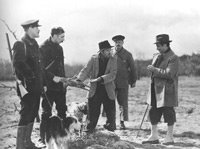Renoir's Rules?

I've had a mini Renoirfest from Netflix recently, seeing Rules of the Game, The French Can Can, and Elena and Her Men. The latter two are enjoyable but fairly slight entertainments, but the first lives up to its status as one of the great movies. To be honest, though, it took me a while to get to that response, and I went through a pretty odd viewing arc over the course of the film (which is already receding in memory, since I saw it a couple of weeks ago). The movie is a skillfully constructed farce centering on a weekend house party at an aristocratic country estate (Altman's Gosford Park owes a lot to it), but I found it difficult to get invested in the characters and the "screwball" comic elements often seemed merely frenetic and zany rather than actually funny. So for part of the movie I found myself thinking that a good Cary Grant film, say with Irene Dunne by his side, could do the same thing better--that is, with more warmth and genuine humor . But Renoir was more interested in giving a serious, even scathing, portrait of "class" than most Hollywood directors have been, and this is where the film develops its real power. And like lots of viewers before me I found its famous hunting scene to be especially intense and moving. I had heard or read the term "beaters" before, but to see a line of men moving forward through the fields and woods beating the ground, the trees, and the bushes with sticks, driving all the animal life before them, so that the waiting aristocrats can blast these animals to bits with shotguns is to be presented with a striking scene of terror, both utterly realistic and highly symbolic (of this society's barely veiled violence). What makes the scene so staggering, and keeps it from coming across as too schematic or propagandistic? That sort of alchemy is one of art's great mysteries, a subtle and unpredictable mix of inspiration and technique, and the way it works here is a sign of Renoir's tremendous talent. To be able to say anything more, I'd have to go back, watch again, and think more about how this is actually achieved. All I can say now is that the scene sneaks up on you, so that you suddenly find yourself in the middle of a massacre, wishing you were not seeing what is before you even as you can't take your eyes away from the screen. I said the film was already receding in memory, but this is one of those scenes that stays with you for a lifetime. And for bonus points, this same scene pays off all over again at the end of the film, so that the death by shotgun of the film's aviator "hero" comes at us with a kind of terrible objectivity.

0 Comments:
Post a Comment
<< Home